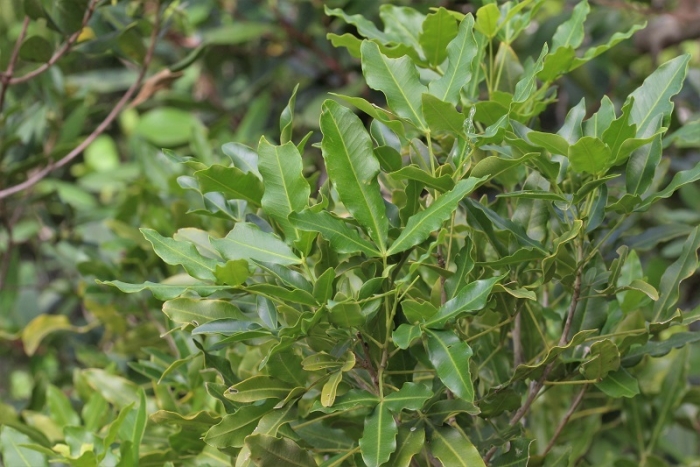White Ironwood
(Vepris lanceolata)
White Ironwood (Vepris lanceolata)
/
/

Karen Eichholz
CC BY 4.0
Image By:
Karen Eichholz
Recorded By:
Copyright:
CC BY 4.0
Copyright Notice:
Photo by: Karen Eichholz | License Type: CC BY 4.0 | License URL: http://creativecommons.org/licenses/by/4.0/ | Rights Holder: Karen Eichholz | Publisher: iNaturalist | Date Created: 2020-04-13T09:26:50-07:00 |

























Estimated Native Range
Summary
Vepris lanceolata, commonly known as White Ironwood or umZane, is an evergreen tree native to the coastal forests, evergreen thickets, and riverine areas of southern and eastern Africa. It can be found from sea level to elevations of 98 feet, often on sandy soils. This species typically grows to a height of 15-20 meters with a canopy spread of 10-15 meters. The tree has a straight, slender trunk with smooth, pale grey bark and a dense, rounded crown. The leaves are compound, glossy, and dark green, contributing to its attractive appearance. White Ironwood produces small, inconspicuous white flowers that are followed by black, berry-like fruits.
White Ironwood is valued for its hard, dense wood, which is resistant to termites and often used in construction. In cultivation, it is appreciated for its lush foliage and is used for shade, ornamental purposes, and as a windbreak in coastal gardens. It requires well-drained soils, tolerates drought once established, and thrives in full sun to partial shade. While it is not commonly available in the nursery trade, it can be propagated from seed or cuttings. Care should be taken as the roots can be aggressive, potentially causing damage to nearby structures.CC BY-SA 4.0
White Ironwood is valued for its hard, dense wood, which is resistant to termites and often used in construction. In cultivation, it is appreciated for its lush foliage and is used for shade, ornamental purposes, and as a windbreak in coastal gardens. It requires well-drained soils, tolerates drought once established, and thrives in full sun to partial shade. While it is not commonly available in the nursery trade, it can be propagated from seed or cuttings. Care should be taken as the roots can be aggressive, potentially causing damage to nearby structures.CC BY-SA 4.0
Plant Description
- Plant Type: Tree
- Height: 15-30 feet
- Width: 10-20 feet
- Growth Rate: Moderate
- Flower Color: White
- Flowering Season: Spring, Summer
- Leaf Retention: Evergreen
Growth Requirements
- Sun: Full Sun, Part Shade
- Water: Medium
- Drainage: Medium
Common Uses
Border Plant, Drought Tolerant, Low Maintenance
Natural Habitat
Coastal forests, evergreen thickets, and riverine areas
Other Names
Common Names: Forest White Ironwood
Scientific Names: , Vepris lanceolata, Asaphes undulata, Boscia undulata, Crantzia lanceolata, Crantzia paniculata, Cranzia lanceolata, Cranzia paniculata, Duncania undulata, Duncania undulata
GBIF Accepted Name: